World Rugby Tackle Height Directive

Welcome to the WRU and World Rugby Tackle Height information page
Watch the Introduction to the New Tackle Height Law video HERE.
The following applies to age groups from Under 12’s to Welsh Women’s Premiership and Male Championship.
As form the 1st of July 2023 the WRU will adopt the new World Rugby Tackle Height directive aiming to lower the legal tackle height to the base of the sternum and below.
Following an extensive six-year study by World Rugby concluding with recommendations to lower the tackle height to provide a safer environment for players and more enjoyable game to play and watch the WRU have taken the decision to apply the laws to our community game.
World Rugby Tackle Height Directive Presentation:
For in depth information regarding the new World Rugby Tackle Height directive please click HERE to watch the full presentation by World Rugby.
As a result World Rugby have outlined the benefits of lowering the tackle height in the community game to:
- Enhanced playing experience and player welfare at the heart of recommendations being made to the World Rugby Council in May
- Independent research supports lowering of the legal tackle height as a means of reducing the number of head impacts and concussions in the community and youth game
- Recent pilot trials in France also show positive outcomes in terms of, player experience and community game participation
- Unions will be encouraged to opt-in to a global law trial reducing the legal height of the tackle at Community and youth levels.
- Unions will be able to determine the exact tackle height within their jurisdiction but World Rugby will recommend a reduction to below the sternum
- The lower tackle height is aimed at increasing accessibility, safety and enjoyment.
RESOURCES:
The following resources outline the details of the new Tackle Height laws and which areas of the game they apply to:
The Tackle
All open play 1v1 tackles must be delivered below the base of the sternum.
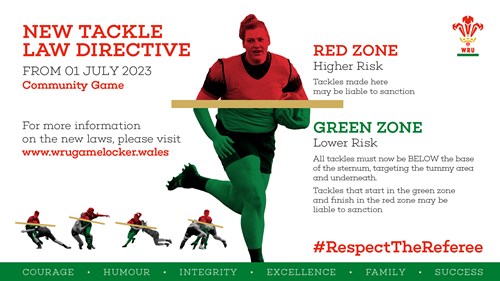

Download the above poster/s:
The Front Tackle
All open play 1v1 tackles from the front must be delivered below the base of the sternum.
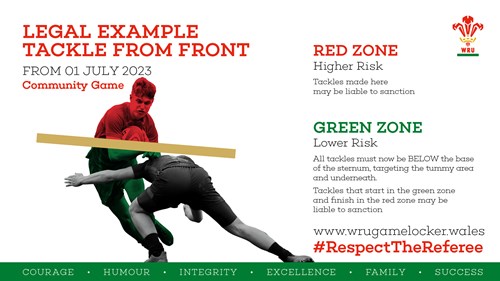

Download the above poster/s:
Side tackle
All open play 1v1 tackles from the side must be delivered below the base of the sternum.
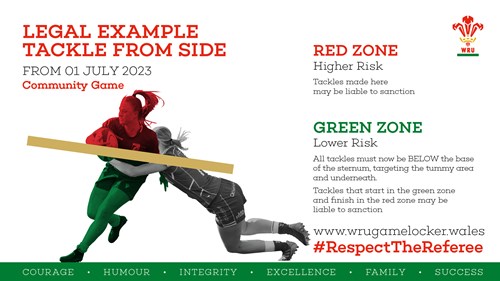
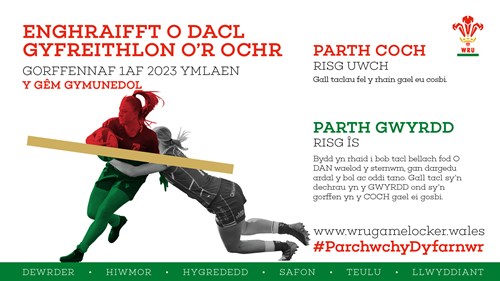
Download the above poster/s:
Rear tackle
All open play 1v1 tackles from the rear must be delivered below the base of the sternum.
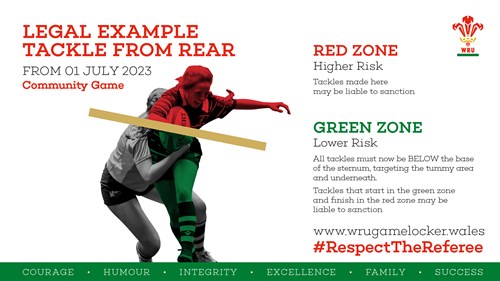

Download the above poster/s:
The Double Tackle
If two defenders both deliver a tackle to the ball carrier both defenders must make contact below the base of the sternum.
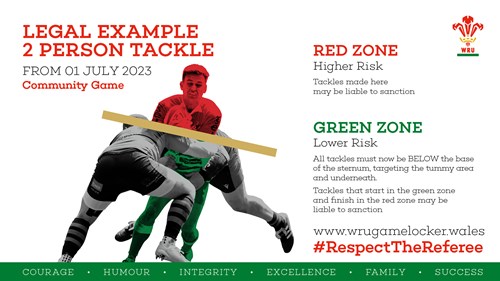
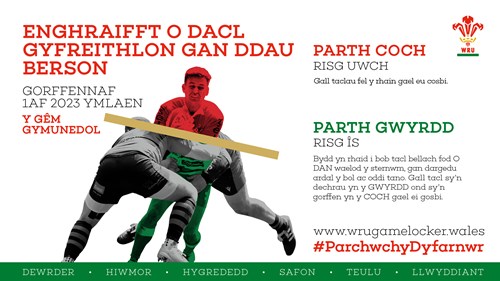
A rip for the ball must not be attempted above the base of the sternum but can be completed below the base of the sternum.
Download the above poster/s:
The Pick and Drive
As a result of the extensive six-year study conducted by World Rugby the Pick and Drive has been deemed low risk for head injuries due to the low velocity of both the ball carrier and defender and resulting the law in this area of the game to be unchanged.
However, if the ball carrier makes the decision to rise upright from the contact area, from their initial low pick and drive position, this action results in the application of the new Tackle Height Law.
The Responsibility of the Ball Carrier
With the new law applying mainly to the defending player making the tackle, the ball carrier also has a responsibility to ensure the tackle is safe.
The ball carrier must not dip into the tackle to the extreme that would bring the tackler and ball carriers heads into the same space.
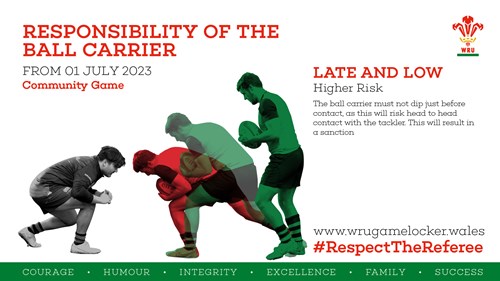
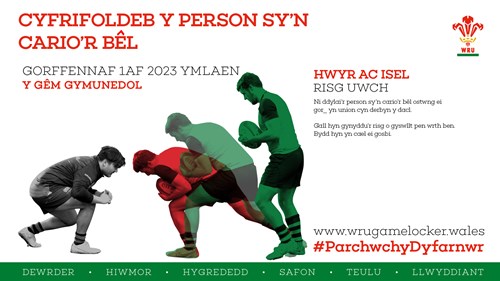
Download the above poster/s:
For further information please read the following FAQ's:
Q: Can you enforce all players to wear scrum caps? Would that reduce risk?
A: Scrum caps are mainly for protecting the ears and reducing superficial head injuries including cuts and abrasions. There is no evidence wearing scrum caps prevent concussion.
Q: What about poor tackle technique?
A: Tackle technique is very important, yes. World rugby have conducted studies on technique and when graded using an objective checklist (which will vary between coaches, of course), the tackles that score worse on technique are more likely to cause concussions. We have, because of the process, arrived at height as the element of technique that can be acted upon.
Q: How can you control and manage this in close contact situations, for example, diving for a try line at close range? We need to focus on tackling correctly in every possible scenario.
A: Education for Players, Coaches and Match Officials will continue to be crucial in this area.
Q: My concern is the safety of TWO defenders who tackle an attacking player CORRECTLY. Head behind the players legs with their arm in front of their legs. Both will be prone to a head-on-head collision behind the attacker's legs.
A: Its very unlikely that both players will have the ability to make contact at the same point in a front on tackle, the only scenario we see is if one tackler is coming from one direction and another from directly opposite, Two side on tackles! To avoid head contact our suggestion is that its practiced one going lower than the other, using communication to aid each others point of contact.
Q: Whilst I’m sure everyone wants to see a safer game and obviously the work you guys are doing is certainly allowing it to head in the same direction, my concern is in the refereeing of it, interpretation by referees is already varied and this is going to create more frustration within the community game. I think sooner we start this at age grade levels the better and an allowance must be given by referees whilst players get used to it
A: Referees will be supported through educational roadshow, via their conferences and digitally supported through the Game locker
Q: One of the differences is medical provision!
A: A big difference, yes. One can argue that we need to be more conservative given the relative absence of that medical support. It’s analogous to recognize and remove compared to HIA off field screens. Where you are under-resourced, you must err on the side of conservative management.
Q: Was there any change in other injuries/severity during these studies with lower tackle laws? i.e. uninteded consequences of law change.
A: Not so far, but we are aware of the possibility that there may be. Especially when you go really low, as per the slide being shown right now. You want players to be in the middle, not too high, not too low. If too low, then knee injuries become a real concern, and we’re trying to encourage people NOT to swing from too high to too low. The research we want to facilitiate must definitely look for these.
Q: Correct me if I am wrong, but hasnt a tackle above sternum height been in the tackle laws going back many years. This stand up tackle has crept into union since the influx of RFL defence coaches?
We believe so, yes. We consulted the defence coaches of the top 10 nations in 2018, and this was the message. So it reassures us, to some extent, that asking players to tackle lower is not asking for something “new”, but rather a return to something that has always been done. There’s no doubt that the creep up of the tackle has been caused in part by instruction from coaches to tackle higher, combined with the tactical imperatives in the tackle. RFL definitely played a role in this
Q: If we are want to get players to tackle correctly. Head in the right area. Something we were taught since we started playing then we watch professionals consistently using poor technique and getting injured. I understand is a faster game and more physical but they train and play at that level and should be able to tackle correctly. When you are blowing after the 10th ruck and you just use poor form. How can this be changed ?? How do you change and improve confidence that players use good form?
A: Technique is where it is at. One way to think about this is that tackle height is a kind of ‘trojan horse’ that is being used to drive better tackle technique, in all aspects, not just height. As you say, heads on the correct side is crucial. There’s a risk that it becomes perceived as SOLELY about height, when it’s actually about many elements.
Q: Agree however this will undoubtedly increase head/shoulder on hip/pelvis with potentially more catastrophic injuries.
A: We have data on tackles and we know that between 35 and 45% of tackles are in this area already and they’re not the ones that cause those injuries. It’s if the tackle dives into the knee that the risk of a catastrophic is highest. We have some data provided by SARU that has helped consolidate this thinking. The risk of a shoulder/head injury at the hip is considerably lower than at the height of the head or the height of the knee, in that order.
In particular, head to head is 8 times more likely to cause a head injury than head to hip, and head to knee is 4 times more likely. If we get heads near torsos, ideally, and hips, next best, the injury number should go down, based on all evidence so far.
Q: Whilst not a tackle… What have been the implications re: Mauls? Have the studies showed a change in their prevalence?
A: Mauls have exceptionally low head injury risk, so theoretically, one isn’t that concerned about them happening. The question would be whether these situations can be identified accurately by the match officials in order to allow it continue? That is, can the ref reliably spot “the maul” and not penalise it? If yes, then there’s no reason to change it, because it’s actually quite safe. As for prevalence, definitely more mauls than ever, because they’re such an effective weapon to score tries.
Q: What about a line printed across the jersey to assist the referee.
A: It’s certainly an option. There may be some practical challenges to standardizing these, for different player sizes and shapes, when the “line” is at a distinct point on the ball carrier’s body. The preference would be to positively officiate a zone, rather than negatively officiate a line. But as a coaching tool, the line may well be helpful.
Q: What is the best way to use this during a university BUCS game such as a welsh university against a english university, both teams will challenge the tackle height due to different union laws?
A: We are in close dialogue with the other home nations and BUCs on this.
Q: That’s what I meant, not head injuries but other injuries such as Shoulder/Neck. I believe it will decrease head injuries and this is good but other injuries may increase in number and severity. I suppose this will require a long term injury surveillance record.
A: Injury surveillance studies will closely monitor this and collate all injuries in addition to head injuries.
Q: What about ball carrying players dipping shoulder to meet tackle from an 'upright' posture (How do/can we envisage this be stewarded/refereed?
A: We would encourage the “upright tackler to lower their height as its themselves running the risk of being sanctioned. If the ball carrier then dips they cannot lead with their head or dip below the height of the tackler. This will result in sanction against the ball carrier.
Q: Over recent seasons refs have been much stricter on the height of tackles, has the effect of this reduced head injuries during your studies? If it has then has the full effect of the changes had the time to be taken fully into account before the new height reduction is implemented.
A: Data is still be collected and we cannot wait to establish that point, we have a duty to make our game safer now!
Q: Are the HIA studies limited to adult games and would the recommendation to lower the tackle height be for juniors to adult community game.
A: If implemented, the new Tackle height laws are going to be from U12’s to Adult (U9s to U11s are still going to tackle below the waist as this encourages them to learn correct tackle technique.)
Q: Are the HIA studies limited to the adult game and would the recommendation to lower the tackle height be for juniors to adult community game.
A: There’ve been some in the community game, but of course there is no HIA in the junior game, so we could only ever look at clear and obvious concussions. The FFR showed a reduction with their height reduction. The law changes will allow us to explore these further. We have done some on adult R&R and the pattern is the same, in terms of what causes risk.
Q: Can you see the creation of mauls becoming a thing of the past?
A: No, I don’t think so. We know that mauls are safe, and so provided the referee can reliably spot a maul, there’s no reason to ban them. So, this is on the practical side of things but there’s no need to push for a ban on them.
Q: What is the timescale for implementation if a change is made?
The girls season finishes end of July, and pre-season games tend to start in August. That doesn't give much time for re-education.
A: July 1st 2023
Q: What guidance has been issued to referees in other countries to better identify the 'sturnum'? should they look for below armpit, nipple..anything else?
A: Support and guidance material will be made available via the Game Locker
Q: Is this going to be amended in the early contact and Junior age grades and if so when will we see the changes on Gamelocker?
A: No change in Early contact, In preparation for the 2023/24 season.
Q: How enforcable would any law changes be if a match official does not endorse any tackle height change
A: The match official would be expected to officiate in line with World Rugby Laws.
Q: What is the expectation on the referee in relation to sanctions? is there going to be a hard line taken on ALL tackles over that sternum line being penailsed or are we going to be afforded the ability to manage that ourselves taking into account how far above that line the tackle is made?
A: Support and guidance material will be made available, via the referee conferences that will be delivered in July.
Q: Is this going to be amended in the early contact and Junior age grades and if so when will we see the changes on Gamelocker?
A: up to U12 remains the same, tackle below the waist as this promotes tackle technique, 21st of June will see the launch and all information will then be found on the game locker.
Q: Waist height tackle up to U14s would be great and then proposed EPP sessions for (U15s and U16s) could pick up the change in tackle tech as height is taken up to sternum? Deepens purpose for EPPs???
A: The new Tackle height laws are going to be from U12’s to Adult (U9s to U11s are still going to tackle below the waist as this encourages them to learn correct tackle technique.)
Q: Did the evidence from the French waist height change show increased head contact injuries from “orange zone” impacts - i.e to knees?
A: Of course, because you replace one with another. It’s a risk substitution model. So, you’re swapping A with B, and you’ll reduce A and see more of B. The point is whether A or B is more risky (per 1000 such instances)? And that’s why they saw the 30% reduction in concussion risk, because the new impacts (hip/orange) are less risky than the previous ones.
Q: I note that WR are allowing unions to make their own decisions on these trials. Is this with a view to eventually making tackle height and surrounding laws the same worldwide?
A: Yes, definitely. The challenge is that every Union has its own contexts and desires, and if a single instruction for each element is passed down, well, we saw from the RFU in January what the outcome would be. I think it’s important for unions to consult and have ownership of their own decisions. That, plus it’s as yet unsure how those ‘parallel’ changes affect risk of injury, so we don’t want to guess before we have some information on which to make an informed decision. We know that lower height is going to reduce injury, but the degree to which complementary change affects this is open for discovery.
Q: Note that the pick 'n' go you passed back to us to discuss, it seems that you should have an informed opinion on this area?
A: As this is a trial period WR are allowing All Governing bodies to try different variations, opinion will be formed from the data collected from these trials, there will be no change to the pick and go.
Q: The biggest impact here is for the taller/bigger player tackling a shorter player. Think of a 9 sniping around the ruck and a taller player having to react in a split second to reduce their height to well below their own sternum.
A: Dropping the height of the tackler should be practiced for this exact reason.
Q: This is such a fundamental change in law that in my opinion this should WR implemented and placed into law. Otherwise, from a refereeing perspective it will be confusing.
A: Each Union has been recommended by WR to trial the variation. It is then for each Union to decide if they will, and at what variation.
Q: What happens in cross border games where unions have different laws on height of tackle? Should there not be uniformity imposed by World Rugby?
A: Each Union has been recommended by WR to trial the variation. It is then for each Union to decide if they will, and at what variation.
Q: Do we not coach ball carriers to carry low into contact and now encouraging tacklers to go low also - will this increase head contact?
A: If the ball carrier then dips they cannot lead with their head or dip below the height of the tackler. This will result in sanction against the ball carrier.
Q: will you be producing clips of community games to help refs rather than high level games for our educational events.
A: Support and guidance material will be made available prior to any potential implementation and yes community clips will be used
Q: This is such a fundamental change in law that in my opinion this should WR implemented and placed into law. Otherwise, from a refereeing perspective it will be confusing.
A: It will be at some point, but the “package” where you lower height AND complement it with parallel changes remains something to discover before making an informed decision. It is inevitable that it will all converge, but if Unions can’t have some ownership over the nuance of the change, I feel it would fail for a lack of buy-in.
Q: Seems odd the A tackler can't make contact with the head, but a BC can.
A: If the BC initiates head contact to the head of the tackler, it should absolutely be penalized. Many would be in favour of making it illegal for the BC to initiate his/her own head contact too, as the FFR did when lowering the height of the tackle.
Q: Was there much difference between the men's and women's game with head injuries?
A: No, the pattern is exactly the same. The difference is scale. In men’s rugby, the risk of head injury for a head height above the sternum in the tackle is 4x higher. In women, it’s 10x higher! But it remains the same, higher carries more risk than lower. We are working on a paper on this right now, should be out soon.
World Rugby Tackle Height Directive
Welcome to the New World Rugby Tackle Height Directive
As form the 1st of July 2023 the WRU will adopt the new World Rugby Tackle Height directive aiming to lower the legal tackle height to the base of the sternum and below.
Following an extensive six-year study by World Rugby concluding with recommendations to lower the tackle height to provide a safer environment for players and more enjoyable game to play and watch the WRU have taken the decision to apply the laws to our community game.
Find Out MoreWorld Rugby Tackle Height Directive Webinar
For in depth information regarding the new World Rugby Tackle Height directive please watch the full presentation by World Rugby.
Find Out MoreThis resource has been tagged...

